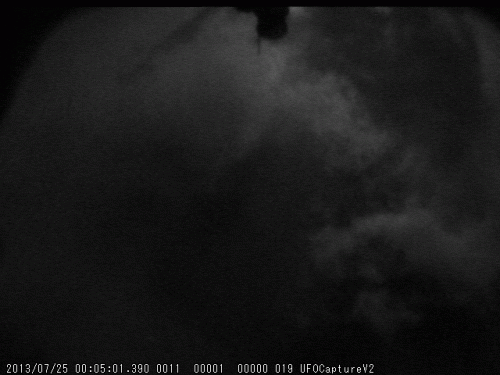Rare atmospheric phenomenon observed

Cameras operated by the Armagh Observatory have recorded one of the very few observations from the UK and Ireland of a very rare atmospheric phenomenon known as a 'sprite'. The detection, which was made around the time of the exceptional thunderstorm that affected Dublin on the 24/25th July 2013, shows a carrot-shaped flash of light, known as a 'sprite', rising high above the thunderclouds as seen from Armagh.
Unlike common lightning discharges, which often jump between clouds or between the clouds and the ground, sprites are associated with similarly powerful electrical fields that occur high above the clouds of the Earth's atmosphere. They are often associated with particularly intense thunderstorms and exceptionally powerful positive cloud-to-ground lightning strokes that are sometimes seen to occur during such storms. Sprites are observed at typical heights ranging from around 50 to 100 kilometres, in the so-called 'middle' part of the Earth's atmosphere known as the mesosphere. This is the region sandwiched between the stratosphere and the much more tenuous thermosphere, which ultimately merges into interplanetary space.
Although visually very faint, in part owing to their distance, and lasting like lightning only for a very short time, sprites are very energetic phenomena and have sizes ranging up to several tens of kilometres across. They are usually red in colour, which is difficult for the human eye to detect, and last at most for up to a few hundredths of a second, which also makes them very difficult to see. Their discovery in the late 1980s was very unexpected, and brought about by the advent of light-sensitive, surveillance-type video cameras. Unlike the human eye-brain combination, these cameras can record information objectively on a continuous basis and with a high data rate, typically around 30 frames a second. They are also more sensitive to red light than the human, dark-adapted eye.

The Armagh Observatory has been operating a cluster of three such cameras since 2005 as part of an effort to characterize meteor activity in this region of the Earth's atmosphere. On the night of the 24/25th July, approximately 15 lightning flashes were detected between 1am and 3am (British Summer Time); and at 01:05 (BST) a luminous, carrot-shaped feature was recorded on the video footage in the SSE direction. It is very difficult to determine the distance and height of this feature from the video footage alone, but its ground location appears to have been at least 30 km from Armagh and possibly up to 60 km or more away, and roughly towards the direction of counties Louth and Dublin.
The attached image sequence shows, left to right, four video frames each separated by 17 milliseconds. These show the sprite appearing (second frame) and, in the time between the second and third frame, appearing to move upwards to terminate in three luminous globes before disappearing very rapidly (fourth frame); by this time the sprite has effectively disappeared.
The overall shape, size and duration of the feature match those of other transient phenomena seen in the upper atmosphere. Within the limits of observation through cloud it appears to be a typical 'red sprite', sometimes called a 'carrot' sprite owing to its distinctive shape. In particular, the feature bears a striking resemblance to sprites recorded above a thunderstorm in Kansas on 10th August 2000.
The Armagh Observatory's video recording is one of the very few sprite detections on video footage from the UK and Ireland. Apart from being extraordinary and awesome to behold, the relatively recent discovery of sprites reminds us that the Earth's upper atmosphere remains a mystery, with a lot still to be learned about the environment of our own planet.
Provided by Armagh Observatory




















